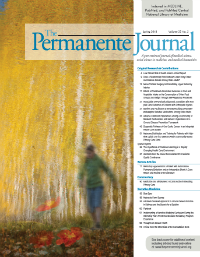Kaiser Permanente's report in NEJM AI details insights from a large-scale rollout of ambient AI clinical documentation technology.
Spring 2018 Edition of the Permanente Journal Now Available
 The latest Permanente Journal is now available for download, and includes a variety of peer-reviewed articles and studies on topics from low cancer risk of South Asians to de-prescribing of sedative medications among older adults.
The latest Permanente Journal is now available for download, and includes a variety of peer-reviewed articles and studies on topics from low cancer risk of South Asians to de-prescribing of sedative medications among older adults.
This edition also includes a special report by Michael Kanter, MD, chief quality officer of The Permanente Federation; and Patrick Courneya, MD, chief medical officer of Kaiser Foundation Health Plan and Hospitals, on the importance of continual learning to transform health care organizations. As part of the special report, abstracts from the annual Kaiser Permanente National Quality Conference from across the Permanente Medical Groups are found in the Journal.
Read more about what’s inside this quarter’s Journal and click on articles of interest below. Or you can download the PDF for the complete edition.
Original Research
Low Cancer Risk of South Asians: A Brief Report
H Nicole Tran, MD, PhD; Natalia Udaltsova, PhD; Yan Li, MD, PhD; Arthur L Klatsky, MD
Logistic regression models were used to study cancer mortality through 2012 in 273,843 persons (1117 South Asians: India, Pakistan, Bangladesh, or Sri Lanka) with baseline examination data from 1964-1985. Death was attributed to cancer in 28,031 persons (1555 Asians, including 32 South Asians). The all-Asian vs. white adjusted odds ratio was 1.0, and the South Asian vs. white odds ratio was 0.5. In separate regressions, South Asians were at lower risk than blacks, Chinese, Filipinos, Japanese, or other Asians. The South Asian-white disparity was concentrated in men.
Does a Relationship Exist Between Lower Body Power and Balance Scores Among Older Adults?
Andrew Shim, EdD; Brady Harr, MS; Mike Waller, PhD
Falls are the second-leading cause of unintentional injury and death worldwide. All participants (13) were assessed stability scores via computerized posturography to determine center of pressure and limits of stability (LoS) balance scores. Participants stood on a perturbed surface with their eyes open and closed. Muscle power output and LoS scores have moderate to strong correlations with balance scores in older adults.
Nerve Transfer Surgery for Penetrating Upper Extremity Injuries
Efstathios Karamanos, MD; Ilya Rakitin, MD; Sophie Dream, MD; Aamir Siddiqui, MD
The authors included cases (16 males, age 16-43 years) performed since 2006 to repair penetrating trauma of upper extremities within 3 months of injury with at least three years’ of follow-up. Six patients underwent nerve transfer surgery because of elbow flexion; 5, finger extension; 3, finger flexion; and 2, wrist pronation. Nine patients had associated vascular injury, and 4 had fractures. All patients improved from 0 of 5 muscle strength preoperatively to a mean of 3.8 within one year after surgery, and in all cases strength was maintained.
Effects of Treatment-Associated Increases in Fruit and Vegetable Intake on the Consumption of Other Food Groups and Weight Through Self-Regulatory Processes
James J Annesi, PhD, FAAHB, FTOS, FAPA
Women with obesity (N = 74, mean age = 47.7 years) participating in a yearlong behavioral weight-loss treatment plan were assessed regarding changes in consumption of various food groups, physical activity, and eating self-regulation. Fruits and vegetables (FV) intake change significantly predicted changes in weight and consumption of dairy and bread products and sweets. The only other notable relationships were among changes in sweets, bread, and dairy consumption over 24 months. During 6, 12, and 24 months, changes in self-regulation significantly mediated the FV intake-weight change relationship. A reciprocal relationship between changes in FV intake and self-regulation also was found.
Association of Psychiatric Diagnostic Conditions with Hospital Care Outcomes of Patients with Orthopedic Injuries
Steven Schwartz, MD; Shahrzad Bazargan-Hejazi, PhD; Deyu Pan, MS; David Ruiz, MD; Anaheed Shirazi, MD; Eleby Washington, MD
From a retrospective analysis of patient discharge data from 507 California hospitals (2001 to 2010), the authors extracted psychiatric diagnoses, alcoholism, substance abuse, and sociodemographic characteristics. The entire injury admissions represented 1.9 percent of hospital admissions and were predominantly older than age 64 years, white, and women with conventional health care insurance. The most common comorbidity was psychiatric illness (24.7 percent). Injury admissions with a psychiatric diagnosis had higher odds of a hospital stay of 7 or more days, surgical treatment complications, and inhospital death.
![]() Barriers and Facilitators to the Deprescribing of Nonbenzodiazepine Sedative Medications Among Older Adults
Barriers and Facilitators to the Deprescribing of Nonbenzodiazepine Sedative Medications Among Older Adults
Jennifer Kuntz, PhD; Louis Kouch, PharmD; Daniel Christian, PharmD; Preston L Peterson, MD; Inga Gruss, PhD
From the perspectives of patients, the greatest challenges to deprescribing are factors related to their insomnia; health care system factors, including a desire for personalized approaches to care; and their own positive personal experiences with sedative medication use. From the clinician perspective, a lack of institutional structures and resources to support deprescribing, the attitudes and practices of previous clinicians, and patient-related factors such as dependence and a lack of alternatives to treat insomnia were the most important barriers to deprescribing.
![]()
![]() Prevalence and Safety of Intravenous Immunoglobulin Administration During Maintenance Chemotherapy in Children with Acute Lymphoblastic Leukemia in First Complete Remission: A Health Maintenance Organization Perspective
Prevalence and Safety of Intravenous Immunoglobulin Administration During Maintenance Chemotherapy in Children with Acute Lymphoblastic Leukemia in First Complete Remission: A Health Maintenance Organization Perspective
Patrick Van Winkle, MD; Raoul Burchette, MA, MS; Raymond Kim, CCRP; Rukmani Raghunathan, MD; Naveen Qureshi, MD
Children with acute lymphoblastic leukemia (ALL) in first complete remission (CR1) experience hypogammaglobulinemia and are at risk of sepsis during maintenance chemotherapy. A multicenter, retrospective cohort study observed 118 consecutive children (9 months-19 years) with ALL in CR1 during maintenance chemotherapy from 2008 to 2014. Groups treated with or without intravenous immunoglobulin (IVIG) were compared using nonparametric statistics. Use of IVIG in children with hypogammaglobulinemia occurred in approximately 30 percent of patients and was well tolerated.
![]() Association of Inflammatory Markers with Disease Progression in Patients with Metastatic Melanoma Treated with Immune Checkpoint Inhibitors
Association of Inflammatory Markers with Disease Progression in Patients with Metastatic Melanoma Treated with Immune Checkpoint Inhibitors
Minggui Pan, MD, PhD; Mubarika Alavi, MS; Lisa J Herrinton, PhD
This retrospective cohort study included 108 patients with malignant melanoma treated with an anti-PD-1 checkpoint inhibitor from August 2014 through December 2015. The median time from initiating therapy to the end of follow-up was 118 days. For patients with metastatic melanoma treated with nivolumab or pembro-lizumab, higher neutrophil or platelet counts, or lower lymphocyte counts, are associated with higher risk of progression. The authors recommend more frequent assessment for progression and closer follow-up, especially for patients with substantial comorbidities or poor physical performance.
![]() The Case for Including Adverse Childhood Experiences in Child Maltreatment Education: A Path Analysis
The Case for Including Adverse Childhood Experiences in Child Maltreatment Education: A Path Analysis
Michael Bachmann, PhD; Brittany A Bachmann, MA, MEd
Survey data examined the impact of child maltreatment education programs and knowledge about adverse childhood events (ACEs) on medical practitioners’ reporting habits and ability to detect maltreatment. The mediating variable “knowledge about ACEs” had the strongest structural effect on the number of Child Protective Services (CPS) referrals, almost twice as high as the second strongest effect of formal education programs. These practitioners were significantly more likely to recognize and to report abuse to CPS.
Adverse Childhood Experiences among a Community of Resilient Centenarians and Seniors: Implications for a Chronic Disease Prevention Framework
Rhonda Spencer-Hwang, DrPH; Xochitl Torres, MPH; Johanny Valladares, MBA; Marco Pasco-Rubio, MPH; Molly Dougherty; Wonha Kim, MD
In a qualitative study, centenarians and seniors in the Loma Linda Blue Zone (1 of 5 worldwide longevity hotspots), childhood exposures and practices were assessed using focus groups and semistructured key informant interviews, and supplemented with lifestyle and resiliency factor questions. Participants (7 centenarians and 29 seniors) reported exposure to multiple adverse childhood experiences (ACEs) (domains: economic deprivation, family dysfunction, and community violence). Community members reported practicing resiliency factors, each with anti-inflammatory properties suggesting mitigation of ACE-related toxic stress.
![]() Diagnostic Pathway of Oral Cavity Cancer in an Integrated Health Care System
Diagnostic Pathway of Oral Cavity Cancer in an Integrated Health Care System
Kevin H Wang, MD; Brian H Song, MD; Jason E Gilde, MD; Jeanne A Darbinian, MPH;Miranda L Ritterman Weintraub, PhD, MPH; Tara J Wu, MD; Eleanor L Yang, MD;James W Salazar, MD; Deepak Gurushanthaiah, MD
In a retrospective study of 247 patients with oral cavity squamous cell carcinoma (2007-2010), 167 (68 percent) had early-stage (I/II) disease, 86 (35 percent) were referred by dentists, and 70 (28 percent) had a history of premalignancy. The median time from symptom onset to care sought from a primary care physician (patient interval), from primary care physician to otolaryngologist, and from otolaryngologist to diagnosis was 8.6, 1.0, 0.0 weeks, respectively. These intervals did not differ by demographic characteristics, clinical factors, or tumor stage. Closer surveillance may represent an opportunity for diagnosis at an earlier stage.
Naloxone Distribution and Training for Patients with High-Risk Opioid Use in a Veterans Affairs Community-Based Primary Care Clinics
Katie E Raffel, MD; Leila Y Beach, MD; John Lin, MD;Jacob E Berchuck, MD; Shelly Abram, LVN;Elizabeth Markle, PhD; Shalini Patel, MD
The quality improvement study was conducted at an outpatient clinic serving 1,238 marginally housed veterans with high rates of comorbid substance use and mental health disorders identified using the Stratification Tool for Opioid Risk Management. None of 67 patients had been prescribed naloxone at baseline. At end-of-intervention (a one-on-one, 15-minute, hands-on naloxone training led primarily by licensed vocational nurses, 61 patients (69 percent) had been trained. This delivery model has the potential to provide access to naloxone to a population of patients with opioid use who may not be engaged in mental health or specialty care.
The Importance of Continual Learning in a Rapidly Changing Health Care Environment
Michael H Kanter, MD; Patrick T Courneya, MD
Abstracts from the Kaiser Permanente 2018 National Quality Conference
Quality improvement (QI) activities are essential to create a learning health care system. Publishing QI activities has great value, encourages greater rigor, and helps facilitate greater willingness to share improvement opportunities.
Review Article
Refractory Hypoxemia in a Patient with Submassive Pulmonary Embolism and an Intracardiac Shunt: A Case Report and Review of the Literature
Jean Liew, MD; Janelle Stevens, DO; Christopher Slatore, MD, MS
The management of acute submassive pulmonary embolism is undertaken on an individualized basis because of the wide spectrum of clinical presentations. In this report the authors review the literature and discuss the evidence behind the management of cases of acute pulmonary embolism complicated by hypoxemia from a patent foramen ovale. In a case of acute pulmonary embolism complicated by refractory hypoxemia from an intracardiac shunt, adjunctive therapies in addition to anticoagulation and thrombolysis must be considered.
Case Reports
Sinonasal Ewing Sarcoma: A Case Report and Literature Review
Jonathan K Lin, MD, MBA; Jonathan Liang, MD
Our literature review found more involvement of the maxillary and ethmoid sinuses compared with the nasal cavity, and that the role of radiation and surgical approach was varied. Ewing Sarcoma of the sinonasal tract is a rare entity with high mortality, but few standardized treatment protocols exist. Further study and evidence-based treatment protocols are needed. This article outlines the role of relevant imaging, a multidisciplinary team approach, and the optimal timing of surgery, chemotherapy, and radiation.
![]() Undifferentiated Pleomorphic Sarcoma after Pirfenidone Use: A Case Report
Undifferentiated Pleomorphic Sarcoma after Pirfenidone Use: A Case Report
Christine A Moore, DO; Aaysha Kapila, MD
![]() Glioblastoma Multiforme in a Patient with Multiple Myeloma: A Case Report and Literature Review
Glioblastoma Multiforme in a Patient with Multiple Myeloma: A Case Report and Literature Review
Christine A Moore, DO; Moayed Ibrahim, MD; Aaysha Kapila, MD;Kailash Bajaj, MD
Image Diagnosis
ECG Diagnosis: Accelerated Idioventricular Rhythm
Thomas H Gildea, MD; Joel T Levis, MD, PhD, FACEP, FAAEM
Accelerated idioventricular rhythm (AIVR) is a ventricular rhythm of three or more consecutive monomorphic beats, with gradual onset and gradual termination. AIVR is usually seen during acute myocardial infarction reperfusion (following thrombolytic therapy or percutaneous coronary intervention), and rarely manifests in patients with completely normal hearts or with structural heart disease.
Commentary
Meditation and Mindfulness: A Call to Action in Elevating Primary Care
Ami Kapadia, MD
Mindfulness meditation has vast physiologic benefits that can reduce physician burnout and improve physician well-being. Collective meditation and mindfulness practices with organized continuity among physician groups can synergistically elevate the practice of primary care by fostering creativity and innovation needed for sustainable solutions. A cohesive frontline physician voice rooted in higher purpose cultivated by meditation and mindfulness practices in a platform directly linked to quality improvement can lead to meaningful change in primary care for all.
![]()
![]() A Practical Guide for Physicians and Health Care Workers to Reduce Their Carbon Footprint in Daily Clinical Work
A Practical Guide for Physicians and Health Care Workers to Reduce Their Carbon Footprint in Daily Clinical Work
Maximilian Andreas Storz, MD
![]() One Leader’s Journey Toward Empanelment
One Leader’s Journey Toward Empanelment
Kathryn A Teng, MD, MBA, FACP
Narrative Medicine
Blue Eyes
Patricia Lynes, RN
Unable to move his contractured body, he only communicated with his beautiful blue eyes. He would blink and squeeze your hand when you asked him if he wanted to go home. His doctors, therapists, and nurses had become his family.
Nebraska Farm Scenes
Lisa Schuman, NP
It seemed as though her daughters, in suppressing their angst over the death and dying of their mother, overshadowed the real patient. The girls, in their 60s, insisted that pictures of their dead father surround the patient’s head so that when she opened her eyes they would be all she would see. She wanted the pictures replaced with images of farmland and cattle.
A Patient-Centered Approach to a Rural General Practice in Distress and the Search for a Solution
Venetia Young, MB, FRCOG, dipFT; Lewis Mehl-Madrona, MD, PhD;Barbara Mainguy, MA
A general practice in rural UK (Cumbria) was overwhelmed by staff burnout. The authors conducted an audit using the electronic health record for patients coming to the practice 5 or more times annually (2008-2012), and planned an intervention—genogram, psychoeducation, and up to six 30-minute sessions of solutions-focused psychotherapy, in which difficult interpersonal relationships were identified and efforts made to resolve 1 major problem related to those relationships. The frequency of visits for patients with mental health conditions (41 percent of all frequent attenders in the practice) dropped significantly, and this intervention had beneficial impact on practitioners and improvement in the morale of the staff.
Fishbowl
Eileen Ogasawara-Chun, MD
I saw the head of the baby start to emerge, then I was guiding the baby out. “Hold tight. They’re slippery little devils.” I heard nothing then. No shouts of joy. No “It’s a boy! No crying of relief. “Then I felt a nudge. It was the attending. He said, “You don’t need to hold that tight; the kid’s got to breathe.”
Implementing a Narrative Medicine Curriculum During the Internship Year: An Internal Medicine Residency Program Experience
Tiffany Wesley, MD; Diana Hamer, PhD; George Karam, MD
Narrative medicine develops professional and communication skills that align with Accreditation Council for Graduate Medical Education competencies. Six sessions, implemented throughout 1 academic year, expose first-year internal medicine residents (interns) to narrative medicine. In total 17 interns attended at least 1 narrative medicine session; each session averaged 5.4 attendees, and 13 eligible interns completed the survey with 3 predominant themes: Mindfulness, physician well-being, and professionalism. This intervention demonstrates the value of a narrative medicine curriculum during medical resident training.
Thoughts on Sexual Health
Kelly Isbill, DO
As a practicing obstetrician-gynecologist for more than 18 years, I have realized the importance of sexual health as well as the embarrassing lack of training in this very important part of our patients’ overall mental and physical health. If anyone should be expected to be not only comfortable but knowledgeable about sex, it should be us. Unfortunately, many of us had little or no education in sexual health during medical school or residency. I have been on a journey to educate myself so I might better help my patients.
A View from the Other Side of the Consultation Desk
Sarah Nicole Dunkerley, BMBS, MA (Oxon), MRCS (Eng), PGCert (ME)
In this reflection on being both a physician and a patient, I consider the events that happened to me as a patient with cancer and how this will change my practice as a doctor in the future.
![]() Three Sides to Every Story: Preparing Patient and Family Storytellers, Facilitators, and Audiences
Three Sides to Every Story: Preparing Patient and Family Storytellers, Facilitators, and Audiences
Lisa Hawthornthwaite; Taylor Roebotham; Lauren Lee, MA; Mim O’Dowda; Lorelei Lingard, PhD
Nursing Research & Practice
![]() The Rural Inpatient Mortality Study: Does Urban-Rural County Classification Predict Hospital Mortality in California?
The Rural Inpatient Mortality Study: Does Urban-Rural County Classification Predict Hospital Mortality in California?
Daniel T Linnen, PhD(c), MS, RN-BC; John Kornak, PhD; Caroline Stephens, PhD, MS, RN, GNP
Soul of the Healer
California Flower Bloom
Jorge Ramirez, MD
Poppies
Abdalla Mallouk, MD
Dance in the Clouds
Shenshen Dou, MS
Status Single
Sapna Reddy, MD
Harmony
Sapna Reddy, MD
On The Cover
Birch Lake
Shenshen Dou, MS


